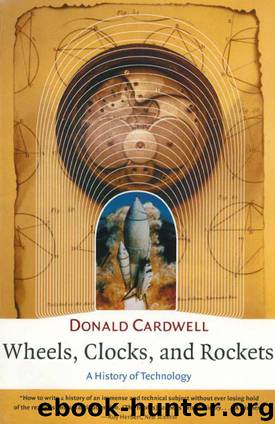Wheels, Clocks, and Rockets by Donald Cardwell

Author:Donald Cardwell
Language: eng
Format: epub
Publisher: W. W. Norton & Company
Water Power in the United States
Another ancient craft that came close to technological perfection by the middle of the century was that of water power. Running water was still the major source of power for American mills, forges and factories. Steam engines were used largely for transportation, by river boat or railroad. American millwrights were craftsmen concerned with small water-wheel installations in relatively isolated farms or small communities. However, as in Britain, there were also large textile mills and, although the New England states were well endowed with rivers and streams, as a textile mill prospered and expanded so the demand for greater power and more efficient machines made itself felt.
It was easy enough to design a water-wheel which roughly approximated to the conditions that the water entered without shock and left without velocity. The buckets had to be big enough to hold all the water that poured in and the wheel should turn slowly so that the water left without appreciable velocity. The column-of-water engine could, more nearly, approach the ideal and, in addition, could utilize a far greater head of water than any water-wheel but, like the water-wheel, it had its limitations. The high-speed turbine was the nineteenth-century answer to virtually all problems. Its successful development depended on additional factors: the capacity to manufacture large iron machines with greater precision than the eighteenth century could attain and with better instrumentation and theory than the eighteenth-century millwrights and engineers possessed. In particular there was the problem of ensuring that the water entered the buckets tangentially, with minimum turbulence, which meant matching the velocity and direction of the water to the velocity of the wheel; and there was the highly complex problem of determining the optimum shape for the buckets. Losses due to turbulence, a minor factor that could be ignored in the case of the overshot water-wheel, were a serious matter in the case of high-speed turbines. The problems of the turbine were, therefore, both theoretical and experimental.
Professor Layton6 has called attention to the work of two New England millwrights, Arthur and Zebulon Parker, in the third and fourth decades of the century. The tradition of the millwright-improver was one that America had in common with Britain. The Parker brothers were disciples of Oliver Evans who, in turn, had been a disciple of John Smeaton. The criteria for deriving the most power from a river or stream were therefore familiar to them. Their science might have been elementary, basic, by Parisian standards, but it was enough for their purposes. They designed and built a fast-running reaction turbine; and, by a fortunate accident – this is reminiscent of Triewald’s account of the discovery of jet condensation – were able considerably to improve the efficiency of the machine. More generally, the achievements of the millwright-improvers recall the work of the Cornish enginewright-improvers who, guided by experience, intuition, a modest amount of science and benefiting from the interchange of ideas with their fellow-workers, were able to take the pumping engine so far along the road to the practical thermodynamic limit for such engines.
Download
This site does not store any files on its server. We only index and link to content provided by other sites. Please contact the content providers to delete copyright contents if any and email us, we'll remove relevant links or contents immediately.
Learning SQL by Alan Beaulieu(6237)
Weapons of Math Destruction by Cathy O'Neil(6215)
Digital Minimalism by Cal Newport;(5704)
iGen by Jean M. Twenge(5385)
Sapiens by Yuval Noah Harari(5322)
The Age of Surveillance Capitalism by Shoshana Zuboff(4245)
Elon Musk by Ashlee Vance(4084)
Thing Explainer by Randall Munroe(3910)
Apollo 8 by Jeffrey Kluger(3667)
Future Crimes by Marc Goodman(3563)
The Science Book (Big Ideas Simply Explained) by DK(3253)
Who Can You Trust? by Rachel Botsman(3111)
The Innovators: How a Group of Hackers, Geniuses, and Geeks Created the Digital Revolution by Walter Isaacson(2994)
I Live in the Future & Here's How It Works by Nick Bilton(2960)
Infinite Energy Technologies by Finley Eversole(2953)
Steve Jobs by Walter Isaacson(2858)
Dawn of the New Everything by Jaron Lanier(2751)
Chernobyl by Serhii Plokhy(2514)
Ben Franklin's Almanac by Candace Fleming(2492)
